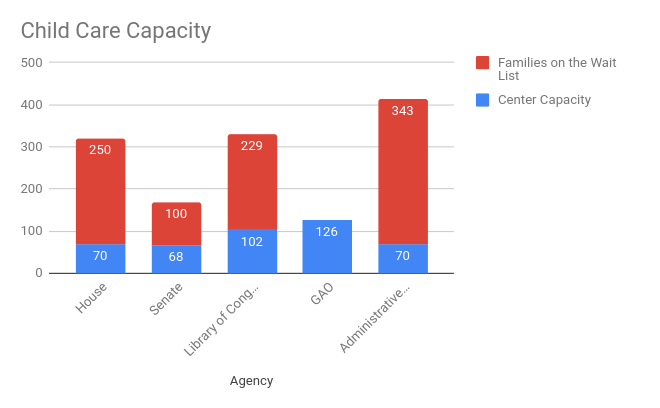It is hard enough to be a congressional staffer, but if you have young children the problem is magnified. Washington, D.C. is the most expensive place in the United States to raise a family, congressional staff work on average 53 hours-per-week when Congress is in session, and child care options in the nation’s capital can be particularly challenging. Given that Congress already faces significant staff retention problems and three-quarters of its staff find their jobs insufficiently flexible in addressing the work-life balance, is Congress doing enough to support staff in taking care of their youngest family members?
Here’s what we found:
- The child care spots available to staff who work in the House, Senate, and Library of Congress are woefully inadequate to meet demand
- The wait lists for infant-care are so long that by the time a position opens up, the average child ages out of infant care.
The House, Senate, and Library of Congress provide a combined 240 spots that are available to the approximately 15,000 legislative branch staff working on Capitol Hill. The House-affiliated facility can take care of only 70 children, the Senate can handle 68, and the Library’s capacity is 102.
More than 579 children are on the wait lists for child care among the three legislative branch facilities on the hill, with the House wait list 250 children deep.
The problem is acute for infants. The child care programs cover children ranging in age from a few months old up to five years old, yet almost half the families on the wait list are seeking care for one-year-olds or younger. One office we contacted suggested that if you want to get your child in, you should get on the wait list the day you find out you’re expecting.
The Government Accountability Office provides day care for young children, and they do a much better job of meeting demand, but its distance from Capitol Hill means it is an inconvenient option. The Administrative Office of the Courts also provides day care and is located near the Senate, but they provide preferential access for Judiciary staff, making it less likely that congressional staff could get a spot.
The issue of child care has recently come back on the Congressional radar. The Senate has directed a study of child care options, pursuant to the FY 2019 legislative branch appropriations report. It will examine the current operating costs of the Senate facility and review personnel processes for hiring and promotions, but more importantly, the study calls for the Architect of the Capitol to evaluate existing facilities under the AOC’s purview and report back within 180 days.
Update: In January the House will expand its child care capacity from 70 to 160 spots. The additional 90 spots will help with some of the backlog, but it is insufficient to deal with the 250 children on the wait list. A second expansion of the facility was funded in the recent appropriations bills, and is expected to increase total capacity to 232 openings — which is an expansion of 162 spots from the current capacity, but there is no publicly-available timetable by which it will be ready.
While these are welcome steps, Congress should look at child care availability across the legislative branch offices and agencies on Capitol Hill, and focus on addressing the needs of infants, which are the hardest to place. Many issues affect congressional staff productivity and retention, and child care could be a significant factor that pushes staff to leave Capitol Hill.
While this is a welcome step, Congress should look at child care availability across the legislative branch offices and agencies on Capitol Hill, and focus on addressing the needs of infants, which are the hardest to place. Many issues affect congressional staff productivity and retention, and child care could be a significant factor that pushes staff to leave Capitol Hill.
In terms of physical facilities, Congress could look at some of its unused facilities, such as the former residence for the House Page Program, as possible venues for a child care facility. It could also look at moving some Capitol Hill offices to the Government Publishing Office buildings, which are no longer being used to capacity, with the goal of freeing up space on Capitol Hill.
Adequate child care is an important issue for all working families. The federal government already has taken a role in providing some assistance to federal employees. According to OPM, there are more than 110 independently operated child care centers across the country in GSA-managed spaces, including 27 in the national capital region.
For the young, overworked, and underpaid congressional staff, Congress must do more to address child care if it wants to retain capable staff.
Download a PDF version of this report here.
— Written by Amelia Strauss and Daniel Schuman

